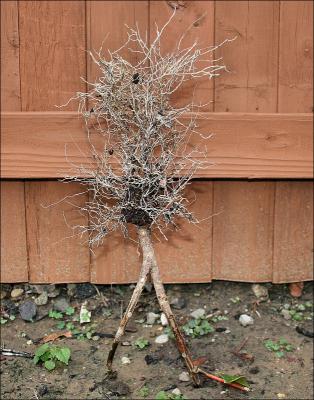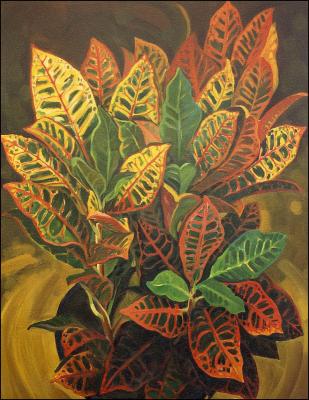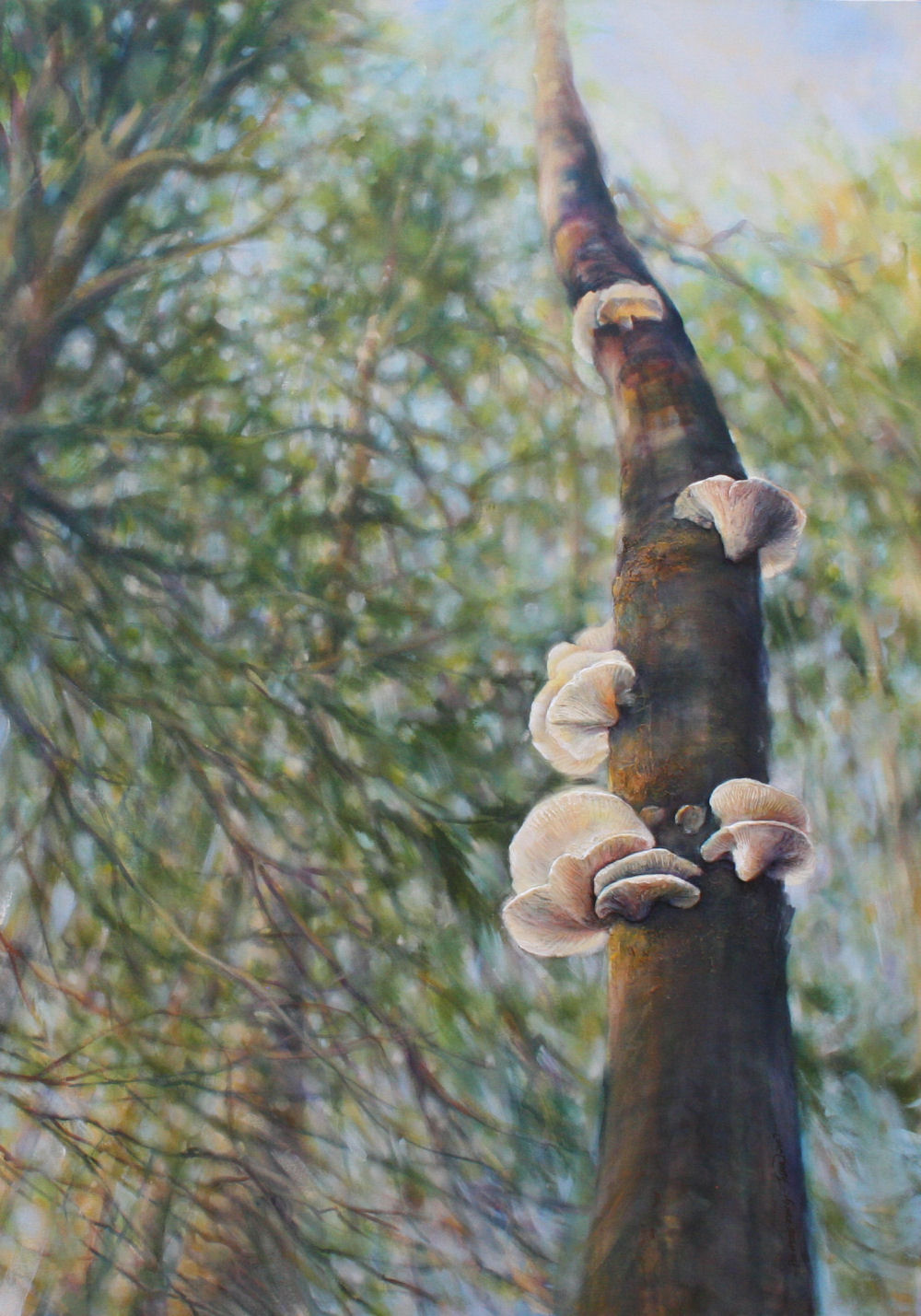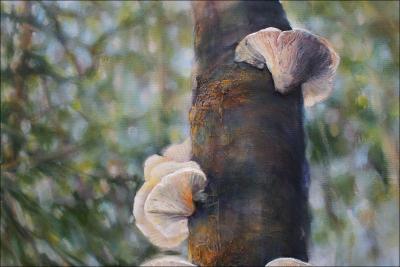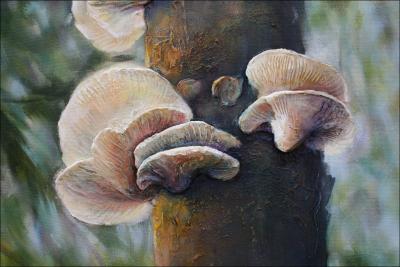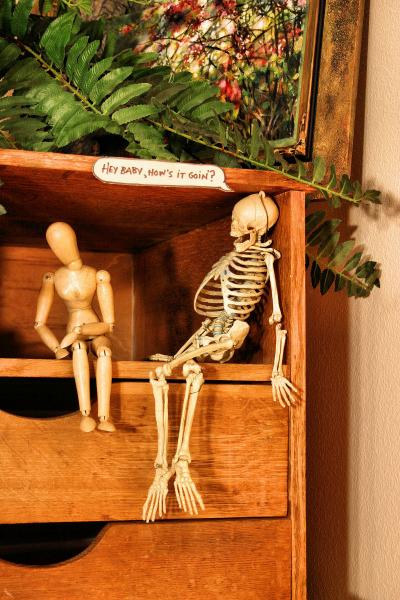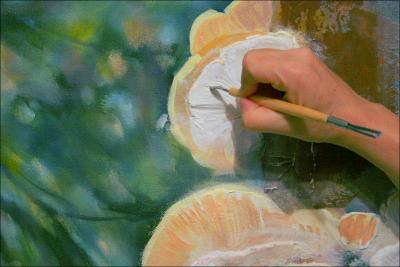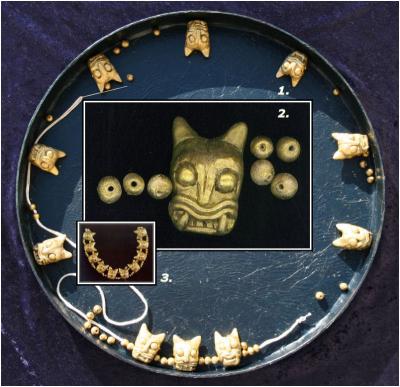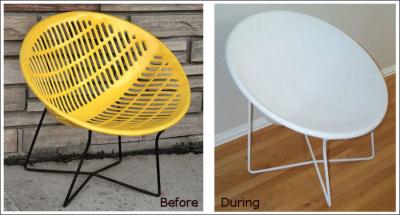3D
Next Entries »Pretty Lady
Friday, December 14th, 2007
So many chores at home preparing for the holidays pull me away from typical art work, but that doesn’t stop the old eyes from spotting things! Transplanting and tidying the garden, shaking soil from dead plants, the root systems are very interesting. I call this one “Pretty Lady”. It’s from a dead Croton — one was posted earlier from a more mature plant.
Art everywhere
Wednesday, November 28th, 2007
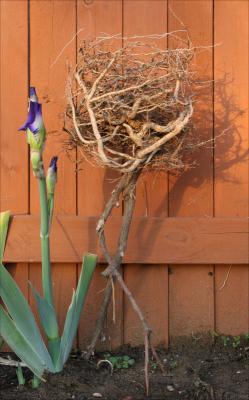
While tidying up the garden and shaking out the soil from dead plants I was marveling at the root systems and couldn’t bring myself to throw this one away, it’s so interesting. This one is from a dead Croton plant, stuck into the ground upside down makes a unique garden sculpture.
Below: Croton, 1992 36 x 24 inches acrylics on canvas (private collection, Scotland).
Polypore Fungi finished
Thursday, November 1st, 2007
Polypore Fungi finished – 58H x 41W x 1.5D inches, acrylics, modeling paste, plaster on canvas, wrapped sides painted, narrow frame
One of the goals for this painting was to see if a composition could remain balanced with the main subject offset to the right. With Petra’s suggestion there is more contrast, also scrubbed some paint away for more background to show through.
Mushrooms, bacteria, molds, lichen and other non-flowering plants are lesser appreciated life forms that help maintain the healthy life cycles of forests by aiding the decay and conversion of plant and animal matter into nutrient-rich soil.
‘Tis the season
Tuesday, October 30th, 2007
“Hey Baby, How’s it goin’?”
Changes to Polypore Fungi
Monday, October 29th, 2007
 The 3D fungi idea was fun to try. The canvas absorbed moisture from the modeling paste, so the faux fungi are permanently incorporated and will not fall off. It was carved after drying, being too goopy to manage while wet. The paste was applied then built gradually, dried before applying more, sanded, scraped and carved to define areas. Commercial modeling paste does not sand well, so a tiny bit of plaster helped to tidy it.
The 3D fungi idea was fun to try. The canvas absorbed moisture from the modeling paste, so the faux fungi are permanently incorporated and will not fall off. It was carved after drying, being too goopy to manage while wet. The paste was applied then built gradually, dried before applying more, sanded, scraped and carved to define areas. Commercial modeling paste does not sand well, so a tiny bit of plaster helped to tidy it.
Four Corners
Wednesday, February 7th, 2007
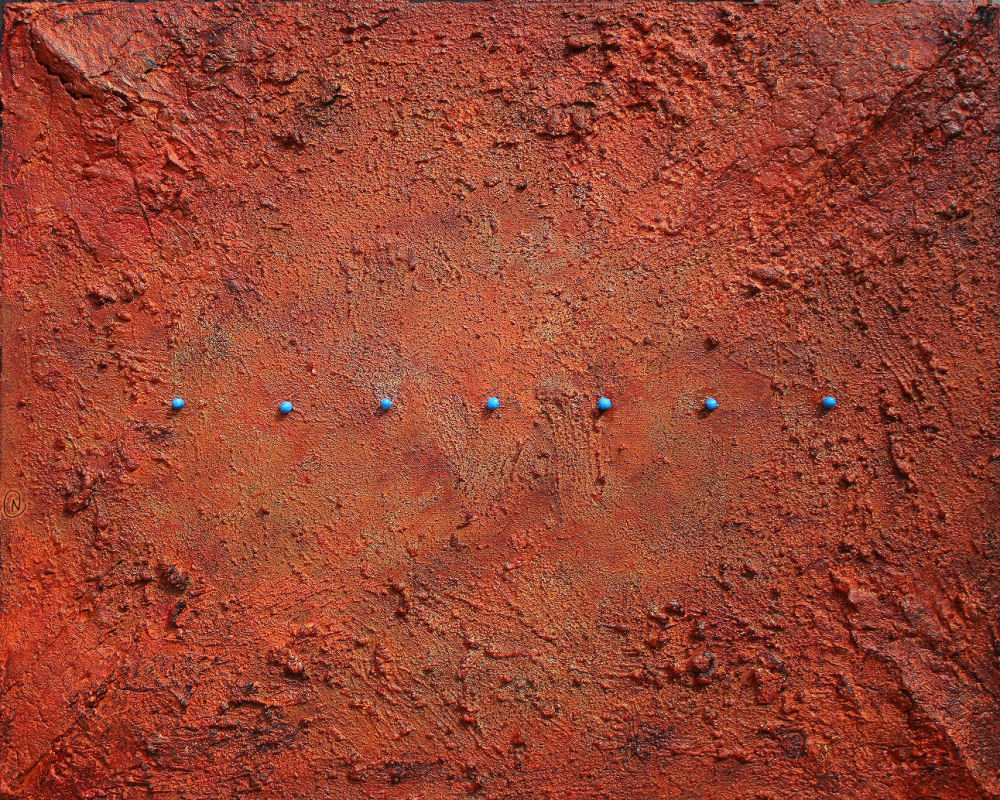
Four Corners, 16H x 20W x 1 inches acrylics, Arizona sand, thick gel medium on canvas.
Inspired by the Four Corners area of western U.S., where Arizona, Utah, Colorado and New Mexico meet. The rocks and soil vary rich shades of red, and turquoise has been treasured and used in everyday objects by Navaho and other tribes in the area for centuries.
Pre-Columbian Jaguar Beads
Thursday, February 1st, 2007
1. the tray 2. the beads 3. a picture of the original necklace.
The Pre-Columbian Jaguar Beads are made of Polymer clay, a permanent material once baked, acrylic paints, varnish, tray re-purposed and paper-mached, painted and varnished for durability.
I was drawn immediately to this Pre-Columbian Mayan necklacewith jaguar beads upon seeing a photo of it, and would love to own it. Well, making one is the next best thing! The original necklace of gold jaguar head-shaped beads was made over 500 years ago, discovered in a tomb in Guatemala.
Like much of the pre-historic and tribal art that looks crude or seems like it should be easy to recreate, there is a lot more here than meets the eye. One of the things that’s so enjoyable about a project like this is experiencing the same design dilemmas that the original artist might have encountered.
There is a lot of good design in that simple-looking necklace! I think the goldsmith who created the original might have used a mold because each individual jaguar head-shaped bead needs to be identical, and so do the small round ones in order to string the beads together and obtain the exact uniform semi-circle shape. Mine were individually shaped, less than perfect, and did not fit together well unfortunately. I’ll need to make a mold from one of the more perfect beads in order to replicate this with consistancy.
The jaguar beads are glued onto a useful tray, a recycled film case that was paper mached then painted with acrylic, and it’s as if a moment in time is recaptured, a moment when the original artist had beads on a surface, ready to be strung together. The refurbished tray is varnished, durable and useful. Hand wash gently with damp soapy cloth, and the crevices with a wet paintbrush, dabbing the area softly to absorb excess moisture.
Ancient Mayan Bowl Chair
Thursday, March 30th, 2006
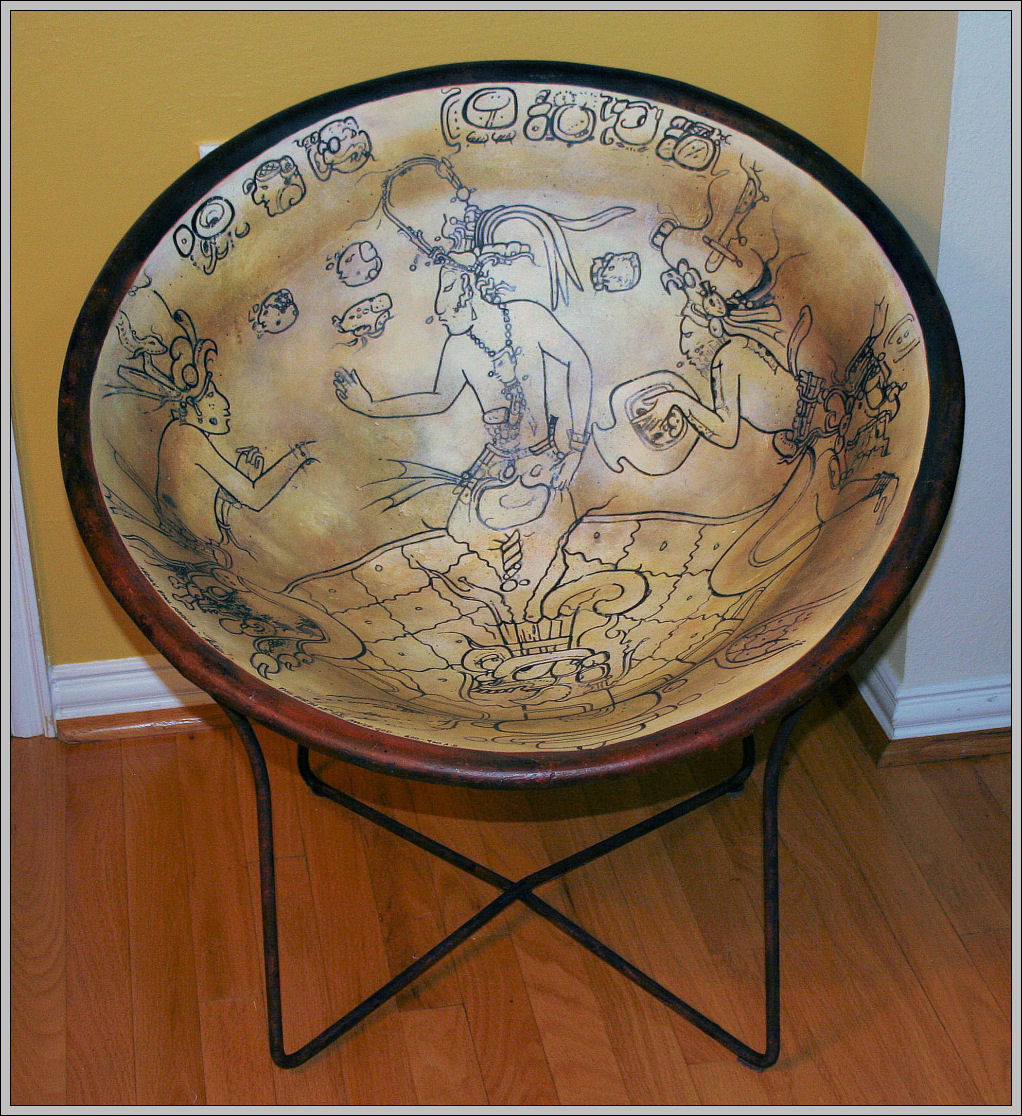
Mayan Bowl Replica Chair, 29H x 29W x 29D inches durable, functional, comfortable refurbished vintage 1960’s plastic lawn chair, mixed media: woven canvas strips, plaster cured and painted, varnish and wax.
This replica of an ancient Mayan artifact re-utilizes a vintage plastic lawn chair that was considered Art in its own day. The refurbished chair was created by a process of weaving canvas strips and white glue paper-mache style over the entire plastic top and bottom, layering wall plaster sanded in between coats, acrylics paint, varnish, graphite, marker, more varnish, then waxed for durability. Three more chairs are yet to be created with historic Art themes from other cultures.
The original bowl design is from the Late Classic Period of Mayan history, 600 – 900 A.D. Common Era, portraying two water Gods witnessing the birth of the all-important Maize God who emerges from a turtle, symbol of the earth and origins thereof. Customarily, hieroglyphs written along the top rim show the bowl-owner’s name and what the bowl was used for.
Inspirational resource: Maya, Divine Kings of the Rainforest edited by Nikolai Grube ISBN 3-8290-4150-0
Post-dated notes: Accepted into Grand Prairie Arts Council Juried Exhibition and Sale Sept./Oct. 2007, and won Second Place cash award, 3D Category. Also accepted into Artjury.com’s 2007 Fall/Winter Juried Online Exhibition.
Pebbles, set of 4 Mosaics
Wednesday, January 25th, 2006
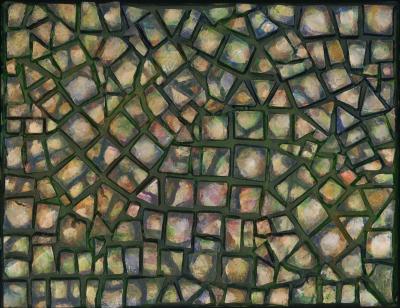
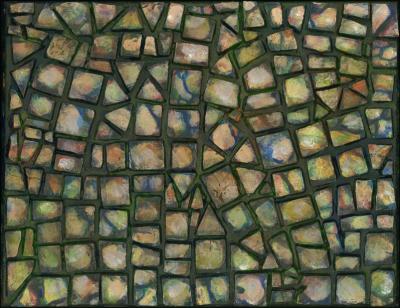
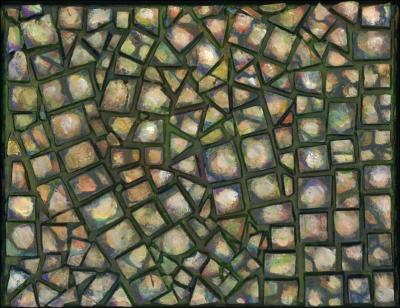
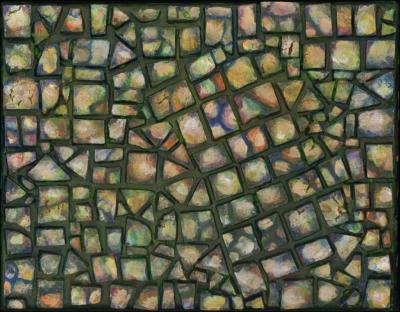
Pebbles Mosaics – Part of the Zen Garden series. Set of four 8 x 10 x 1 inch mixed media on canvas, wrapped edges painted. Hand-made tiles, acrylics, varnished, and sides painted to look like more mosaic around the edges. The tiles are made of a trade-secret recipe, rolled out, cut and air-dried, then have many applications of acrylic paint and varnish.
Each piece in the set is different and can be placed in any order to create a pattern or pathway of “pebbles”. Very versatile, the four 8 x 10 inch mosaics are wired to be arranged on the wall in a number of ways, and changed for variety in decor or wall sizes: vertically, horizontally, in a square configuration or linear sideways or lengthwise.


